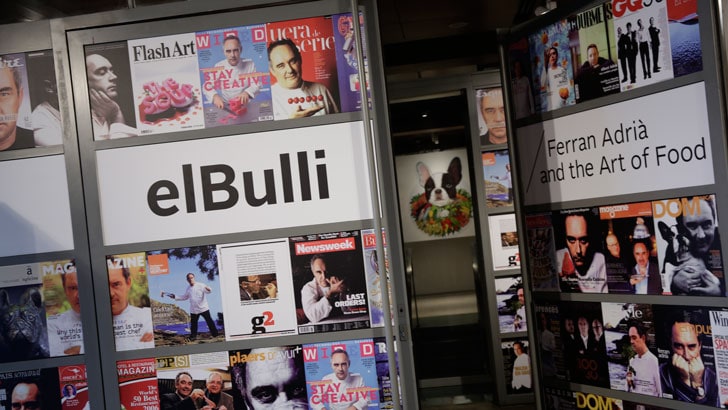
The story of how Spanish restaurant elBulli evolved to be voted the world’s best restaurant is encapsulated in elBulli: Ferran Adria and The Art of Food exhibition at London’s Somerset House, on until 29 September.
This retrospective relates elBulli’s 50 year history through a series of interactive, historical displays. The restaurant, which closed on 30 July 2011, used to receive two million reservation requests for 8,000 places a year. The exhibition also charts the career of Ferran Adria, globally recognised as a pioneer of innovative culinary techniques.
The exhibition transferred from Barcelona, Spain and as Claire Catterall, head of exhibitions, Somerset House says, “The biggest challenge was fitting it into our gallery. It came fully formed from Barcelona so we had to rearrange and adjust it.
“Personally I think it’s better than at Barcelona. Here, the timeline exhibit is fitted continuously in one room whereas in Barcelona, it had to be broken up into three different rooms.”
The exhibition starts with “The Last Supper”, which was served on 30 July, 2011, when elBulli closed. A huge screen shows footage of Adria at the restaurant on that historical night along with other displays. This is Catterell’s favourite section. “I love the giant sized meringue bulldog sculpture unveiled on the closing day of elBulli. In Barcelona this section was at the end of the exhibition, but we flipped it around so it’s at the beginning. We thought it was important to let people, who weren’t familiar with elBulli, understand how well thought of it was and how the chefs worked together to create that last meal.”
Staff were vitally important at elBulli and “The Last Supper” section includes a list of all the chefs and service staff who worked at the restaurant, appealing for anyone whose name hasn’t been included to get in touch.
Further into the exhibition, other screens dominate the far walls revealing daily life in the restaurant, so you feel part of the dining experience. Visitors are able to experience table service at elBulli at one display, as two people can sit at a table and be served ‘virtually’ by means of an overhead projector. Founded in 1956 by Dr Hans Schilling and his wife Marketta at Cala Montjoi in Costa Brava, Spain, the restaurant was named after Marketta’s French bulldogs or “bullis”. Incredibly, as pictures and early menus show, elBulli started life as a mini golf centre, grill room and bar, but by the mid 1970s, Jean-Louis Neichel had secured the first Michelin star.
As the original appointment letter shows, Ferran Adria arrived at eBulli on work experience in 1983, but soon joined the payroll and within six months was appointed co-head chef. At the age of 25 in 1987 Adria took charge of the kitchen and after meeting Jacques Maximin, one of the chefs of the nouvelle cuisine movement, he adopted his philosophy of “creativity means not copying”. Glass cases and display boards illustrate examples of the dishes he created such as vanilla potatoes with crayfish and avocado pear shavings with brown crab.
As Catterall says “It’s incredible elBulli kept so much information, photographs and documents and fascinating to learn how Adria created the concepts. They were light years ahead. You don’t get a sense of this until you see the timeline. Adria, who was instrumental in curating the exhibition for Barcelona, loved it here and was pleased it came to London.”
Upstairs at the exhibition, 1990 marked a change for elBulli as Adria and Juli Soler, the long-serving restaurant manager became co-owners.
Adria opened a laboratory where he trained his team in the theory and practice of creativity, to share his philosophy and invent new methods. It was here in 1994, he invented the ‘panaché’ – pureed vegetable, an iconic dish. As demonstrated by the displays, creating new dishes was a meticulous process taking pictures of every dish and making plasticine models of the food to see what it looked like on the plate. Astonishingly, elBulli catalogued every dish served since 1987, numbering them up to 1,846 until the restaurant closed. Thumbnail pictures of every dish can be seen in an illuminated montage. Alongside one wall is an interactive display of recipes throughout elBulli’s 50 years with a picture of the dish, the date and a video screen showing the food being prepared. It was a fascinating insight into how the restaurant’s cuisine developed. This exhibit certainly gets the tastebuds going, but unfortunately there is no food to sample.
A strong message from the exhibition is that the restaurant will leave its legacy. The elBullifoundation will include the conversion of the restaurant into a museum and visitor centre and ‘elBulli DNA’ where experts will experiment in creativity and post the results online. There is a preview of Bullipedia, another Foundation project, comprising online mindmaps of food and recipes that people can share.
As Adria says “Even though elBulli restaurant is closed, its spirit is very much alive and this exhibition is one of the ways of keeping it so.”
It seems that the ethos of elBulli will be with us for many years to come.
Jackie Mitchell
